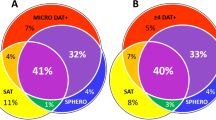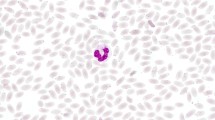Abstract
Haematological findings, at presentation, in 35 cases of canine autoimmune haemolytic anaemia (AHA) were documented. A regenerative anaemia was not found in all cases of AHA. The range of haematological findings spanned a spectrum from aplasia, through normocytic/normochromic red cell morphology, to marked regeneration. Primary AHA was compared to secondary AHA with respect to haematological parameters and some differences were recorded: the degree of anaemia being significantly more marked in the primary cases. In some cases, red cell parameters were not considered reliable due to spurious red cell indices being obtained. The haemoglobin value and reticulocyte count in absolute numbers provided accurate data characterising the type of anaemia.
Similar content being viewed by others
References
Abkowitz JL, Kadin ME, Powell JS, Adamson JW (1986) Pure red cell aplasia: lymphocyte inhibition of erythropoiesis. Br J Haematol 63:59–67
Ammus SS, Yunis AA (1987) Acquired pure red cell aplasia. Am J Hematol 24:311–326
Anderson MN, Mouritzen CV, Gabrielli ER (1966) Mechanisms of plasma hemoglobin clearance after acute hemolysis in dogs: serum haptoglobin levels and selective deposition in liver and kidney. Ann Surg 164:905–912
Avolt MD, Lund JF, Picket JC (1973) Autoimmune hemolytic anemia in a dog. J Am Vet Med Assoc 162:45–46
Baldini M, Pannacciulli I (1960) The maturation rate of reticulocytes. Blood 15:614–629
Bennett D (1980) The naturally occurring inflammatory arthropathies of the dog. PhD Thesis, University of Glasgow, pp 317–325
Bennett D (1984) Autoimmune disease in the dog. In Pract 6:74–93
Bennett D, Finnett SL, Nash AS, Kirkham D (1981) Primary autoimmune haemolytic anaemia in the dog. Vet Rec 109:150–153
Berendes M (1973) The proportion of reticulocytes in the erythrocytes of the spleen as compared with those of circulating blood, with special reference to hemolytic states. Blood 14:558–563
Bundza A, Lumsden JH, McSherry BJ, Valli VEO, Janzen EA (1976) Hemobartonellosis in a dog in association with Coombs' positive anemia. Can Vet J 17:267–270
Cline MJ, Berlin NI (1963) The reticulocyte count as an indicator of the rate of erythropoiesis. Am J Clin Pathol 39:121–128
Cline MJ, Golde DW (1978) Immune suppression of hematopoiesis. Am J Med 64: 301–310
Conley CL, Lippman SM, Ness PM, Petz LD, Branch DR, Gallagher MT (1982) Autoimmune hemolytic anemia with reticulocytopenia and erythroid marrow. N Engl J Med 306: 281–286
Crosby WH, Rappaport H (1956) Reticulocytopenia in autoimmune hemolytic anemia. Blood 11; 929–936
Cruz WO, Junqueira PC (1952) Resistance of reticulocytes and young erythrocytes to the action of specific hemolytic serum. Blood 7:602–606
Dacie JV, Lewis SM (1975) Practical haematology. 5th edn. Churchill Livingstone, Edinburgh
Dear MG (1970) Clinical aspects of autoimmunity in animals. J Small Anim Pract 11:685–696
Dodds WJ (1977) Autoimmune hemolytic disease and other causes of immune-mediated anemia: an overview. J Am Anim Hosp Assoc 13:437–441
Dodds WJ (1983) Immune-mediated blood diseases in dogs. Mod Vet Pract 64:375–379
Evans RJ, Gruffydd-Jones TJ, Jones DRE (1987) Anaemia in dogs. Veterinary annual, 27th edn. Scientechnica, Bristol, pp 243–256
Fehr J, Knob M (1979) Comparison of red cell creatine level and reticulocyte count in appraising the severity of hemolytic processes. Blood 53:966–976
Feldman BF, Kaneko JJ (1981) The anemia of inflammatory disease in the dog. 1. The nature of the problem. Vet Res Commun 4:237–252
Ford RB (1984) Immune-mediated hemolytic anemia. Vet Technician 5:398–401
Halliwell REW (1978) Autoimmune disease in the dog. Adv Vet Sci Comp Med 22:221–263
Harvey JW (1980) Canine hemolytic anemias. J Am Vet Med Assoc 176:970–974
Hegde UM, Gordon-Smith EC, Wortledge SM (1977) Reticulocytopenia and ‘absence’ of red cell autoantibodies in immune haemolytic anaemia. Br Med J 2:1444–1447
Hillman RS, Finch CA (1969) The misused reticulocyte. Br J Haematol 17:313–315
Hinton MH, Jones DRE (1977) Anaemia in the dog: an analysis of laboratory data. J Small Anim Pract 18; 701–706
Hinton MH, Jones DRE (1978) The haematological examination of canine blood samples received by post: the influence of delay in examination on red cell parameters. J. Small Anim Pract 18: 95–99
Hoffman R, Zanjani ED, Lutton JD, Zalusky R, Wasserman LR (1977) Suppression of erythroid colony formation by lymphocytes from patients with aplastic anemia. N Engl J Med 296:10–13
Issitt PD (1974) Auto-immune hemolytic anemia. Am J Med Tech 40:479–495
Jacoby RO, Griesemer RA (1970) Immunologic injury to dogs. Adv Vet Sci Comp Med 14:149–191
Jandl JH (1966) The pathophysiology of hemolytic anemias. Am J Med 41:657–666
Jonas LD, Thrall MA, Weiser MG (1987) Non-regenerative form of immune-mediated hemolytic anemia in dogs. J Am Anim Hosp Assoc 23:201–204
Jones DRE (1986) Use of an enzyme indirect antiglobulin test for the diagnosis of autoimmune haemolytic anaemia in the dog. Res Vet Sci 41:187–190
Jones DRE, Darke PGG (1975) Use of papain for the detection of incomplete erythrocyte autoantibodies in autoimmune haemolytic anaemia of the dog and cat. J Small Anim Pract 16:273–279
Jones DRE, Hall DE (1991) The assay of canine serum haptoglobin and its diagnostic implications. A comparison of two assay techniques. Comp Haematol Int 1 (in press).
Jones DRE, Gruffydd-Jones TJ, Stokes CR, Bourne FJ (1990) An investigation into factors influencing performance of the canine antiglobulin test. Res Vet Sci 48:53–58
Jones DRE, Stokes CR, Gruffydd-Jones TJ, Bourne FJ (1987) An enzyme-linked antiglobulin test for the detection of erythrocytebound antibodies in canine autoimmune haemolytic anaemia. Vet Immunol Immunopathol 16:11–21
Krantz SB, Kao V (1967) Studies on red cell aplasia I. Demonstration of a plasma-inhibitor of heme synthesis and antibody, to erythroblast nuclei. Proc Natl Acad Sci USA 58:493–500
Krantz SB, Kao V (1969) Studies on red cell aplasia II. Report of a second patient with an antibody to erythroblast nuclei and a remission after immunosuppressive therapy. Blood 34:1–13
Laber J, Perman V, Stevens JB (1974) Polychromasia or reticulocytosis — an assessment of the dog. J Am Anim Hosp Assoc 10:399–406
Lewis RM (1974) Spontaneous autoimmune diseases of domestic animals. Int Rev Exp Pathol 13:55–82
Lewis RM, Schwartz RS, Gilmore CE (1965) Autoimmune diseases in domestic animals. Ann NY Acad Sci 124:178–200
Lewis RM, Henry WB, Thornton GW, Gilmore CE (1963) A syndrome of autoimmune hemolytic anemia and thrombocytopenia in dogs. Scientific proceedings of the 100th annual meeting of the American Veterinary Medical Association, New York. pp 140–163
Liesveld JL, Rowe JM, Lichtman MA (1987) Variability of the erythropoietic response in autoimmune hemolytic anemia: analysis of 109 cases. Blood 69:820–826
Lockner D (1974) Quantitation of erythropoiesis by a new method. IV. Studies using 59Fe and DP32P simultaneously in haematological diseases. Scand J Haematol 13:146–151
Mackenzie CP (1969) Idiopathic (acquired) haemolytic anaemia in the dog. Vet Rec 85:356–361
Marmont A, Peschle C, Sanguineti M, Condorelli M (1975) Response of three patients to cyclophosphamide and/or antilymphocyte globulin (ALG) and demonstration of two types of serum IgG inhibitors to erythropoiesis. Blood 45:247–261
Miller G, Swisher SN, Young LE (1954) A case of autoimmune hemolytic anemia in a dog. Clin Res Proc 2:60–61
Mills JN, Day MJ, Shaw SE, Penhale WJ (1985) Autoimmune haemolytic anaemia in dogs. Aust Vet J 62:121–123
Morris TCM, Vincent PC (1982) Inhibitory cells in aplastic anaemia. Br J Haematol 50:706–710
Owen JA, Smith R, Padanyi R, Martin J (1964) Serum haptoglobin in disease. Clin Sci 26:1–6
Penny RHC, Carlisle CH, Davidson HA; Gray EM (1970) Some observations on the effect of ethylenediamine tetra-acetic acid (EDTA) on the packed cell volume of domesticated animals. Br Vet J 126:383–389
Perman V, Schall WD (1983) Diseases of the red blood cells. In: Ettinger SJ (ed.) Textbook of veterinary internal medicine, 2nd edn, Vol 2, W. B. Saunders, Philadelphia, p. 1981
Petz LD, Garratty G (1980) Acquired immune hemolytic anemias. Churchill Livingstone, New York
Pirofsky B (1976) Clinical aspects of autoimmune hemolytic anemia. Semin Hematol 13:251–265
Rice JD, Mathies LA (1960) Comparison of resistance of reticulocytes and mature erythrocytes to immune haemolysis. Arch Pathol 70:435–440
Schalm OW (1975) Autoimmune hemolytic anemia in the dog. Canine Pract 2:34–45
Schalm OW (1980) Autoimmune hemolytic anemia. In: Manual of feline and canine hematology. Veterinary Practice Publishing Co., Santa Barbara, CA, pp 157–165
Schalm OW, Ling GV (1969) Hematological characteristics of autoimmune hemolytic anemia in the dog. Calif Vet 23:19–24
Schwartz RS, Costea N (1966) Autoimmune hemolytic anemia: clinical correlations and biological implications. Semin Hematol 3:2–26
Sears DA (1968) Plasma heme-binding in patients with hemolytic disorders. J Lab Clin Med 71:484–494
Shinton NK, Richardson RW, Williams JDF (1965) Diagnostic value of serum haptoglobin. J Clin Pathol 18:114–118
Sieff C (1983) Pure red cell aplasia. Br J Haematol 54:331–336
Slappendel RJ (1978) Hemolytic anemia in the dog. PhD thesis, University of Utrecht.
Slappendel RJ (1979) The diagnostic significance of the direct antiglobulin test (DAT) in anaemic dogs. Vet Immunol Immunopathol 1:49–59
Sokol RJ, Hewitt S, Stamps BK, Hitchen PA (1984) Autoimmune haemolysis in childhood and adolescence. Acta Haematol 72:245–257
Spurling NW (1977) Haematology of the dog. In: Archer RK, Jeffcott LB (eds.) Comparative clinical haematology. Blackwell Scientific Publications, Oxford, p 403
Stefanelli M, Barosi G, Cazzola M, Orlandi E (1980) Quantitative assessment of erythropoiesis in haemolytic disease. Br J Haematol 45:297–308
Stockham SL, Ford RB, Weiss DJ (1980) Canine autoimmune hemolytic disease with a delayed erythroid regeneration. J Am Anim Hosp Assoc 16:927–931
Switzer JW, Jain NC (1981) Autoimmune hemolytic anemia in dogs and cats. Vet Clin North Am 11:405–420
Taniguchi S, Shibuya T, Morioka E, Okamura T, Okamura S, Inaba S, Niho Y (1988) Demonstration of three distinct immunological disorders on erythropoiesis in a patient with pure red cell aplasia and autoimmune haemolytic anaemia associated with thymoma. Br J Haematol 68:473–477
Thompson RB (1977) Disorders of the blood. Churchill Livingstone, Edinburgh
Troy GC, Vulgamott JC, Turnwald GH (1980) Canine ehrlichiosis: a retrospective study of 30 naturally-occurring cases. J Am Anim Hosp Assoc 16:181–187
Weiss DJ (1986) Antibody-mediated suppression of erythropoiesis in dogs with red blood cell aplasia. Am J Vet Res 47:2646–2648
Weiss DJ, Miller ML, Crawford MA, Johnson CA (1984) Primary-acquired red cell aplasia in a dog: response to glucocorticoid and cyclophosphamide therapy. J Am Anim Hosp Assoc 20:951–954
Weiss GB, Bessman JD (1984) Spurious automated red cell values in warm autoimmune hemolytic anemia. Am J Hematol 17:433–435
Werner LL, Bloomberg MS, Calderwood Mays MB, Ackerman N (1985) Progressive polysystemic immune-mediated disease in a dog. Vet Immunol Immunopathol 8:183–192
Wilkins RJ, Hurvitz AI, Dodds-Laffin WJ (1973) Immunologically mediated thrombocytopenia in the dog. J Am Vet Med Assoc 163:277–282
Wolff A (1979) Autoimmune anemia in a dog presented for foreign body gastritis. Calif Vet 33:17
Yoshida M, Takaku F, Nojiri H, Miura Y, Saito M (1987) Decreased sialic acid content of erythrocytes in patients with aplastic anaemia. Br J Haematol 65:351–355
Author information
Authors and Affiliations
Additional information
Correspondence and offprint requests to: Department of Immunology, University Hospital Queen's Medical Centre, Nottingham, NG7 2UH, UK.
Rights and permissions
About this article
Cite this article
Jones, D.R.E., Gruffydd-Jones, T.J. The haematological consequences of immune-mediated anaemia in the dog. Comparative Haematology International 1, 83–90 (1991). https://doi.org/10.1007/BF00422878
Issue Date:
DOI: https://doi.org/10.1007/BF00422878




